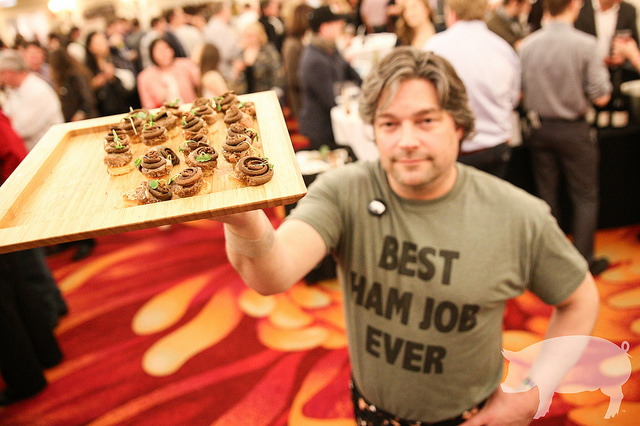Five Porky Lessons Of Cochon 555
By Melissa McEwen in Food on Apr 14, 2014 9:00PM

One of a great many pork dishes to eat at Cochon 555 (Image Courtesy of Galdones Photography/COCHON 555)
Cochon 555 can feel a tad overwhelming. Five chefs, five pigs, five wineries and more than enough beer, cider, oysters and cheese make it quite the party. It all adds up to over thirty dishes of pork to taste—a tough fit in anyone’s belly. But from what I did taste, it was clear there were some hits and misses. Even the misses offered lessons about how to cook up tasty pork.
Do: Take a lesson from cultures that revere pork, especially when cooking a heritage pig. Heritage pigs tend to be fattier than their modern industrial counterparts and have more flavor. Some cultures have been cooking with these breeds of pigs for hundreds or even thousands of years. Abraham Conlon of Fat Rice made good use of that collective wisdom with his sarapatel, a dish from the Western Indian coastline that utilizes pork offal in a fragrant sour-spicy sauce.
Don’t: Drown the pork in sugar. Many dishes at Cochon unfortunately just tasted like sugar. It’s sad to hide the distinct flavors of these unique pig breeds in a cloyingly sweet glaze.
Do: Utilize the pig’s natural flavors. The bones, especially when roasted, provide ample flavor for rich broths, like that used in Ryan McCaskey of Acadia's deeply meaty ramen. Unfortunately, few dishes really showcased porky flavors.
Don’t: Add more fat than you need. Heritage pigs usually have more than enough fat to go around. A few heritage pigs are slightly lean yet still contain plenty of fat. When you are drowning in lard, you don’t need someone to throw you a slab of foie gras or a cup of butter. It was subversively decadent about seven years ago. Now it’s just obnoxiously greasy and unbalanced. Which brings us to...
Do: Find a way to balance all of that fat. You know the classic salad dressing combination of oil and vinegar? It’s classic for a reason—the acidic vinegar complements the oil’s flavor and texture by reining it in a bit. Chefs can accomplish this balance with refreshing tangy ingredients. It’s no coincidence that Cochon 555’s winner was Tim Graham of Travelle, who didn’t hold back on the tanginess—the smoked pineapple in the Piri-Piri Pork Belly, a lemony chermoula and radish tzatziki in tacos and lime in a head cheese and mole soup.